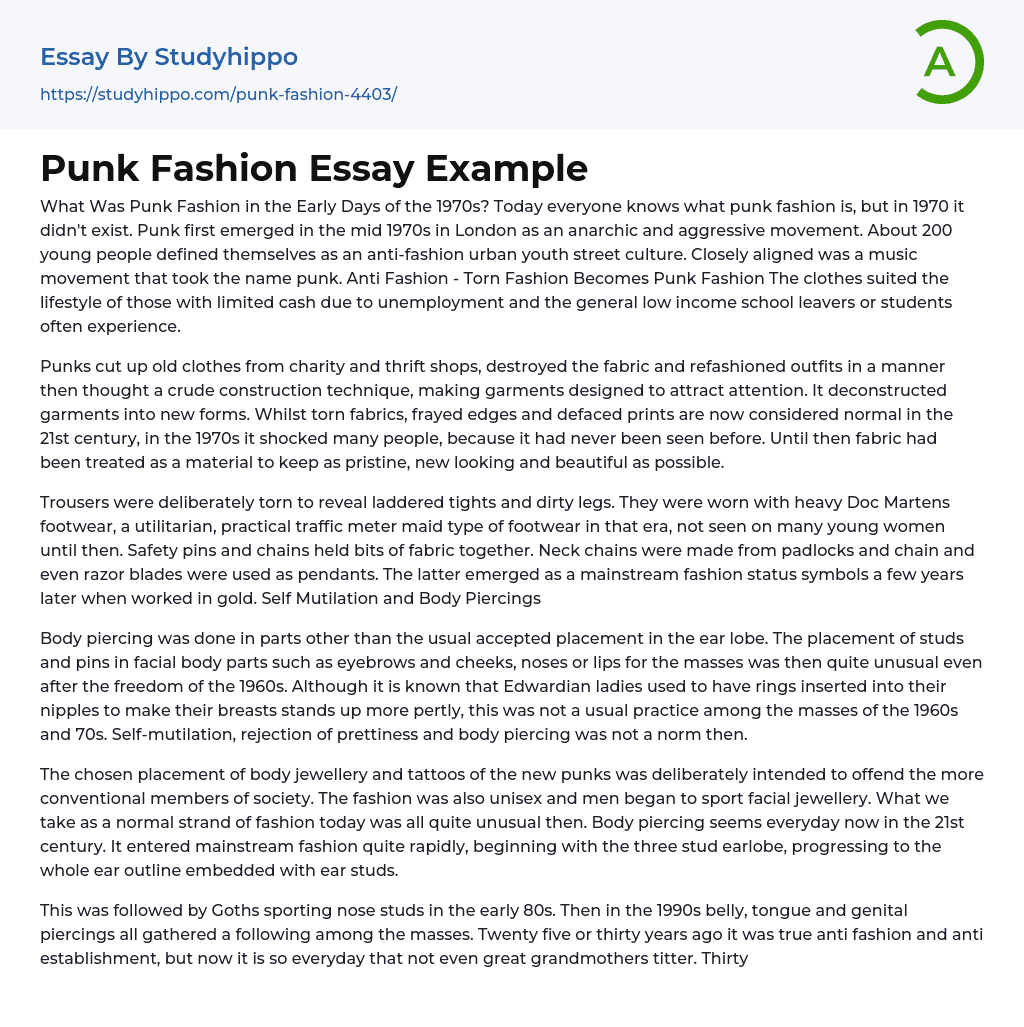During the early days of the 1970s, punk fashion did not exist. However, it started to emerge in London in the mid-1970s as an anarchic and aggressive movement, closely associated with a music scene that adopted the name punk. Approximately 200 young individuals identified themselves as part of an anti-fashion urban youth street culture. The clothing style of punk fashion reflected the economic circumstances of those affected by unemployment and low income, such as school leavers and students.
Punks repurposed clothing from charity and thrift stores, tearing and reconstructing them in what was considered a crudely designed manner, with the intention of drawing attention. This process involved deconstructing existing garments and transforming them into new forms. In contrast to the 21st century where ripped fabrics, frayed edges, and altered prints are now accepted as normal, these unconventional
...fashion choices in the 1970s were shocking as they had never been witnessed before. Prior to that era, fabric was typically regarded as a material meant to be maintained in its original pristine, brand-new, and aesthetically pleasing condition.
Trousers were intentionally ripped to expose laddered tights and filthy legs. They were paired with chunky Doc Martens shoes, a functional and practical choice inspired by traffic meter maids, which was unconventional for young women at that time. Safety pins and chains were used to fasten pieces of fabric. Padlocks and chains were fashioned into necklaces, and even razor blades were worn as pendants. These items eventually transformed into mainstream fashion symbols a few years later when crafted in gold. The trend of self-mutilation and body piercings emerged alongside this fashion movement.
During the 1960s and 70s, body piercing in areas othe
than the ear lobe was considered unconventional. It was uncommon for the general population to have studs or pins placed in facial body parts like eyebrows, cheeks, noses, or lips, even after the liberation of the 1960s. Although it was known that Edwardian ladies sometimes had rings inserted into their nipples to enhance their breast appearance, this was not a common practice among the majority of people during the 1960s and 70s. Self-mutilation, rejection of conventional beauty standards, and body piercing were not considered normal during that time period.
The new punks purposely selected the positioning of body jewellery and tattoos to intentionally offend conventional individuals in society. The fashion was also gender-neutral, with men embracing facial jewellery. What is now considered common fashion today was quite unconventional during that time. In the 21st century, body piercing has become commonplace. It quickly gained popularity in mainstream fashion, starting with three studs on the earlobe and advancing to the entire outline of the ear adorned with ear studs.
This was followed by Goths sporting nose studs in the early 80s. Then in the 1990s belly, tongue and genital piercings all gathered a following among the masses. Twenty five or thirty years ago it was true anti fashion and anti establishment, but now it is so everyday that not even great grandmothers titter. Thirty years after Punk emerged as a rebellious youth oriented fashion many grandmothers and great grandmothers sport a tattoo or piercing somewhere on their body. » Bondage in Early Punk Fashion
The early punks were characterized by black leather, studs, chains, various fabrics, faded black T-shirts soaked in sweat, and bondage animal print bum flaps
and leg straps. These looks were considered provocative and sexual at the time, as evidenced by the written references and dyed and destroyed vests. However, these styles have now become mainstream, with people wearing T-shirts with slogans like "fcuk" or carrying a graffiti-printed Louis Vuitton bag. This acceptance of bold fashion choices is thanks to the influence of the early punk movement.
Vivienne Westwood and Malcolm McLaren opened a shop called Seditionaries, formerly known as 'Sex', on the Kings Road in London. The shop sold leather and rubber fetish goods, with a particular focus on bondage trousers. It was through this shop that Westwood and McLaren popularized punk as a style, which was further fueled by McLaren's launch of the 'Sex Pistols' punk music group. After their partnership ended, Westwood renamed the shop as 'World's End'.
Vivienne Westwood's concepts swiftly manifested in the more youthful Pirate and Romantic aesthetics. Despite being perceived as impractical, these collections frequently inspired other designers, giving rise to another trend. As her skill progressed, Westwood's attitudes and methods underwent shifts. She adeptly merged tailoring techniques with a touch of panache, lightheartedness, and allure to produce fresh fashions that were emulated by others. With a series of groundbreaking accomplishments, Vivienne Westwood is currently acknowledged as one of the most innovative fashion creators of the 20th century.




